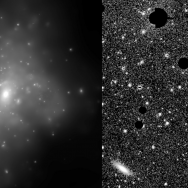Despite a century of measurements, astronomers can’t agree on the rate at which the universe is expanding. A technique that relies on measuring distances to a specific type of aging star in other galaxies—called the J-region Asymptotic Giant Branch, or JAGB method—might be able to help.
Astrophysicist and University of Chicago graduate student Abigail Lee is the lead author on a new paper that analyzed observations of light from a nearby galaxy to validate the JAGB method for measuring cosmological distances. This novel technique will allow future independent distance measurements that can help answer one of the biggest outstanding questions in cosmology: how fast is the universe expanding?
“One of the most exciting questions in cosmology today is whether there is new physics that is missing from our current understanding of how the universe is evolving. A current discrepancy in the measurement of the Hubble constant could be signaling a new physical property of the universe or, more mundanely, unrecognized measurement uncertainties,” said Wendy L. Freedman, the John and Marion Sullivan University Professor of Astronomy and Astrophysics and senior author on the paper. “There are very few methods for measuring distances that can deliver the required accuracy. Lee is developing this new JAGB method, which shows early promise for resolving this discrepancy.”
A key to the history of the universe
Back in 1920, Edwin Hubble, PhD’17, first noticed the relationship between a galaxy’s distance and how fast it was moving away from us. This value, now known as the Hubble constant, is a key parameter in cosmological models.
Hubble first measured this constant by comparing galactic distance and velocity measurements derived from a specific kind of star that pulses regularly. Measurements using direct methods like Hubble’s have improved greatly over the decades, but they don’t agree with methods that extrapolate from the Cosmic Microwave Background—light leftover from the very early universe. This disagreement is called the Hubble tension, and is one of the most prominent issues of modern cosmology.
An independent measurement method could help bridge the gap between methods and lead to a more decisive view of the Hubble constant as measured directly from distances, the authors said.
That’s where the JAGB method comes in. Stars in the J-region Asymptotic Giant Branch are a specific type of aging giants that contain a substantial amount of carbon in their atmospheres that is brought to the surface by convection currents, giving them a very distinct color and brightness that allows them to be identified in a set of stars within a galaxy.
“We’ve observed empirically that these stars have a known intrinsic brightness from galaxy to galaxy,” Lee said.
This makes them prime candidates for being what astronomers call standard candles. Because the apparent brightness of a star as observed depends on both its distance from the observer and its intrinsic brightness, knowing the intrinsic brightness of a star can allow astronomers to infer its distance.
“Because this method is relatively new, the goal of this project was to see if it could rival other distance indicators in precision and accuracy,” Lee said.
Going to the stars to check
The team selected a galaxy on the outskirts of the nearest group of galaxies, called Wolf-Lundmark-Melotte or WLM, and used data taken from observations with the Magellan Telescopes at Las Campanas Observatory in Chile. By using a single object as the target and applying four different independent measurement methods, the team could compare the accuracy and precision of the JAGB method to previously established methods.
After analyzing the data four different ways, researchers determined that the JAGB method is not only an independent check on other distance measurement methods, but that it requires less observing time—a scarce commodity among a community of astronomers competing for time on a limited number of powerful telescopes.
Because JAGB stars are brighter than stars used in other distance measurements, they can also be seen further away, which will allow for more distant calibrations than are possible with other methods. Additionally, JAGB stars are found in all types of galaxies, as opposed to the pulsating stars used by Hubble, which are found only in the more limited subset of spiral galaxies and often suffer from crowding and significant interference from dust.
“Ideally we’ll get observing time from the James Webb Space Telescope and Hubble Space Telescope to use this method to measure distances to galaxies hosting Type Ia supernovae,” Lee said. Type Ia supernovae are used to measure more distant galaxies, but they need to be calibrated by shorter range distance measurements using techniques like the JAGB method. “Once we do that, we can not only measure the Hubble constant but also compare these various distance methods to see if there are issues with any of them.”
Whether that new, independent value for the Hubble constant agrees with other direct measurement methods or the early-universe measurements will shed light on this question that has long puzzled astronomers and cosmologists.
“We don’t have a firm grasp on the value of the Hubble constant, so this is really important work to help address one of the biggest issues in cosmology right now,” Lee said.
Citation: "The Astrophysical Distance Scale. III. Distance to the Local Group Galaxy WLM Using Multiwavelength Observations of the Tip of the Red Giant Branch, Cepheids, and JAGB Stars." Lee et al, The Astrophysical Journal, Feb. 5, 2021.

